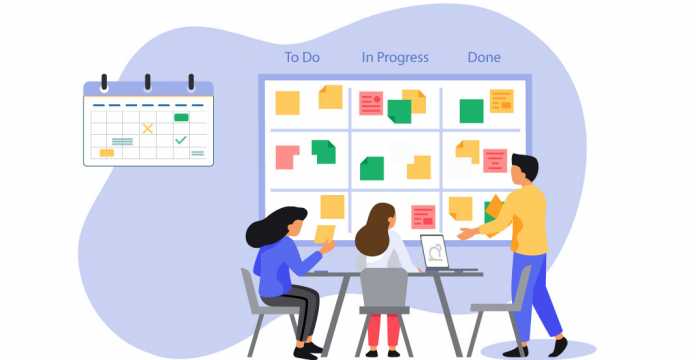
Scrum Framework is a widely used agile methodology to ensure that all the projects are completed on time, and the end result is of the highest value. Lately, more and more industries have begun to adopt Scrum methodology to create a more Agile environment for their projects. It initially started in the software development sector, but Scrum has become widely used across many industries since then. A recent survey conducted stated that 97% of organizations that participated in the study will continue to use Scrum in their future projects.

The Scrum process works in incremental iterations known as sprints during the entire lifespan of the project. The first step to starting any iteration or sprint is to plan for it. It is a crucial step in ensuring the success of the sprint. In this article, explore what sprint planning is and the points that are addressed during this meeting.
Types of Scrum Meetings
There are five main types of Scrum meetings held regularly by Scrum teams.
Daily Standup
The daily standup meetings take place each day of the sprint. The team members get together at a specific time, usually at the beginning of the day, to discuss
- All the tasks that were completed yesterday
- Tasks that will be completed today
- Disruptions or obstructions faced by any team members in their work
It is a short meeting that does not last for longer than 15 minutes, and it is crucial in creating transparency and accountability among team members.
Sprint Planning
The sprint planning meeting occurs at the beginning of each sprint to estimate all the product backlog items, which will be completed in the current sprint duration. Topics like team capacity, prioritization of tasks, and the goal of the sprint are also addressed.
Sprint Review
A sprint review takes place at the end of the sprint. The entire Scrum team gets together and showcases the end result of the sprint with the stakeholders. Here, the team receives feedback from the stakeholders, which can be implemented in future sprints for more effective results.
Sprint Retrospective
Once the review is complete, the Scrum team gets together to reflect upon the sprint, and the feedback received. Improving processes and the internal development of the team is important. All the things that worked and did not work are discussed, and ways to improve future iterations are addressed. These meetings do not last for more than one hour.
Product Backlog Refinement
This Scrum meeting takes place between sprints and lasts around one or two hours. The product backlog refinement meeting involves the entire Scrum team and allows them to evaluate their user stories and understand what will be completed in the next sprint.
It also gives team members the platform to discuss any concerns in any of the processes and ways to make the sprint planning meeting move quicker.
Now that you are aware of all the Scrum meetings, let’s dive a little deeper into Sprint planning.
What is a Sprint Plan?
A sprint plan is a part of the Scrum framework where the entire team gets together to discuss what product backlog items they will be working on in that sprint or iteration. It also has the initial plan on how they will go about completing the selected product backlog items for the sprint. A sprint goal that needs to be achieved by the end of the iteration is also established during the sprint planning process.
What is a Sprint Planning Meeting?
Most Scrum teams, which are approximately 86%, hold a Sprint planning meeting before starting their sprint. They understand the importance of discussing all the important features of the project based on how the product owner has prioritized them. In this meeting, the entire team asks questions that will help them develop and create user stories to help them complete their product backlog items in the sprint.
A sprint planning meeting is the first step in the sprint. As discussed earlier, there are other types of meetings conducted regularly during each sprint with the team members to discuss the team’s progress, review the sprint process, and evaluate it to improve the next round.
Who are the Participants in the Sprint Planning?
Since the sprint planning process involves discussing all the tasks and product backlog items that need to be completed in the sprint, it only makes sense for the entire team to be involved in the sprint planning.
- Different Scrum team members discuss different aspects of the sprint in the planning process. The product owner is responsible for identifying and prioritizing the product backlog items and coming up with a sprint goal
- The Scrum Master is responsible for facilitating the entire sprint planning process. He is in charge of making sure that the sprint plan discussion is an effective one and all the team members are in agreement with the sprint goal
- The team members create a forecast of all the product backlog items they can complete in the sprint duration and ways in which they will complete them
Advantages of Sprint Planning
- An effective sprint plan will get the entire Scrum team aligned on the objectives of the sprint and how those objectives can be met.
- The sprint planning meeting gives team members a platform to communicate so that they can identify all their dependencies better and discuss the capacity they have. This helps in setting achievable targets for the entire team in the sprint
- The sprint planning meeting also helps prioritize the product backlog items so that the most important features and functionalities are completed first by breaking them down into smaller tasks with each sprint
- Once the capacity of each team member is discussed and an active sprint plan is made, it will motivate the team members to complete their tasks on time. All the goals are made in a realistic and achievable manner, which means there are fewer chances of any stressful situations, and burnout can be avoided as well
Disadvantages of Sprint Planning
- If the sprint plan is made with poor estimations, it can lead to failure in tasks by the team members. Team members need to estimate their capacity and workload accurately for sprint planning to work. If that does not happen, the entire sprint can get delayed, causing failure
- The sprint planning process can only work if all team members know how the Scrum framework works. They need to understand the concept of Agile completely and have expertise in working in sprints. If there is no understanding of the Scrum processes, they cannot be implemented successfully
Final Thoughts
A Scrum Master facilitates the entire Scrum team with each sprint till the project gets completed. Getting a Scrum Master certification will help create more Agile teams that follow Scrum principles. This will lead to completing projects that deliver a higher value to the customer, which is crucial to any organization’s success.
To learn more about the different factors involved in the Scrum methodology, we would recommend pursuing popular Agile certification courses from an accredited training provider.
Some of the popular Agile Certification Courses that individuals and enterprise teams can take up are:














